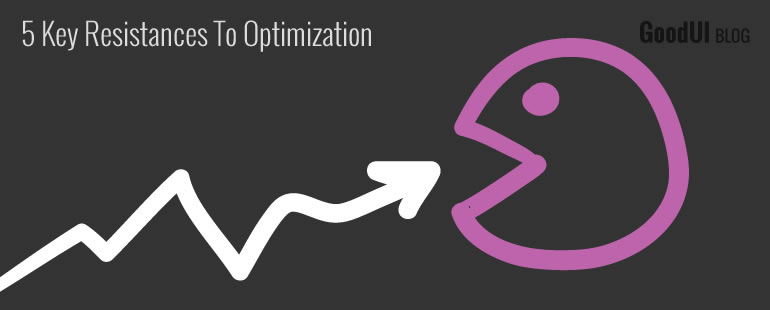5 Key Resistances To Optimization

When we start talking conversion optimization with people who have not done so before, we'll occasionally run into objections. It's only natural that fears, questions, and misconceptions emerge towards novelty. We actually find that the biggest roadblocks to higher conversion have less to do with the ideas being tested themselves, and it is our own beliefs that limit us. If left unanswered, the choice not to optimize swiftly follows and in turn hurts the business in the form of opportunity cost. Here are the most common reasons why we feel some people do not embrace optimization and how we usually address them.
1. Not Knowing What 1% Relative Increase Is Really Worth
Experimentation outputs results in relative terms. A test may finish with a +10% increase to signups, or a +4% ±0.5 increase to sales, etc. Whatever the focus of the project, if you do not know what a potential relative increase is worth to your business, it may deter you from investing and moving forward. The truth is that optimization is an investment where the cost of effort needs to be balanced against potential gains. If you know that a relative 1% increase in revenue turns out to be an extra $1,000 each month for your business, and it costs a few thousand dollars of effort to setup a test that may detect a 5% to 10% gain, then you have a green light to invest. Answer how much 1% is worth to you and clarity of action follows.
2. Poor Test Planning & The Redesign Excuse
When a company decides to do a "redesign" with a wider number of changes across numerous screens, that is a completely valid approach to optimization. This is only true however as long as the company is acting out on high confidence knowledge. In such a case, implementing some changes may be the quickest path to higher conversions (or some other benefit). Approaching redesigns however are sometimes used as an excuse not to start tests and that's often rooted in poor test planning. Knowing where and when the bigger changes will happen, along with proper test estimation is one way to resolve this concern. A second way to address this is by focusing on tests that have higher reuse value which can be carried over into the future, beyond the redesign. If a test is happening on one section of the site in a month, with a proper estimation it will be easier to find out where a test may be squeezed in. There are times to act with force and confidence, and there are times to act with humble experimentation. If done correctly, implementation and testing should dance together.
3. No Development Resources & The Busy Excuse
Every development team is naturally busy with their own roadmaps, todos and agendas. Optimization projects might be stopped dead if the person or team responsible for running the tests does not have enough technical know-how to build out the variations. That's why when starting optimization projects we recommend to setup lower effort tests first, while taking responsibility for the simpler front-end changes ourselves. Only with time, as trust builds up, should tests steer towards higher back-end complexity. Either way, the teams running tests should have coding experience.
4. Fear, Recognition, Aesthetic Preference & The Branding Excuse
Respecting branding requirements and existing teams is important, since tests usually become more successful when they feed off established messages and guidelines. Sometimes however, fear of change, combined with the desire of being in the spotlight, along with aesthetic preference may emerge under the cover of "branding requirements". This can be a very serious optimization deterrent (or towards any change in general). We've seen winning tests not being implemented and sensed teams frown on variations for these very reasons. The way to deal with this is to agree about a/b testing being an experimental method that needs room in order to explore the upside potential. A/B testing requires space. In this context, a winner does not have to be implemented unquestionably. Instead it may be further tweaked and adjusted. Reassuring, listening to and building rapport with existing teams, of course is a long term effort that has to be built over time.
5. The Not-Enough-Traffic Excuse
I fully disagree about the mentality that A/B testing is only for the well established high traffic businesses north of 100k uniques per month, or so. Being able to detect significant effects is a combination of multiple factors such as traffic, base conversion rates, and sensitivity (with enough power). It's completely possible to detect larger effects with thinner traffic pages. Smaller businesses that are not yet optimized have the benefit of a higher upside as more things can be improved (with a larger effect). When optimizing in a business context, one has to realize that the intent is not to make ultra isolated changes which places the cause-and-effect on a pedestal. It is still possible to maximize for the largest possible gains, by grouping multiple changes together while sacrificing some precision of explanation.
If You're Not Optimizing, You're Stagnating
Optimization is a great way to evolve, learn and move your business forward. When you choose to optimize, you open up to the potential for higher conversions. When optimization however is resisted, improvement can be crossed out with a high degree of certainty (aside of random fluctuations). Identify your own resistances and aim higher with experimentation.
Break Through These Resistances By Hiring Us
We offer a wide variety of consulting options to help you reach higher conversions.
 Jakub Linowski on Sep 04, 2015
Jakub Linowski on Sep 04, 2015
Comments
Danny 10 years ago ↑3↓0
You are so right about it. Great post!
I like the ending "If You’re Not Optimizing, You’re Stagnating".
Reply